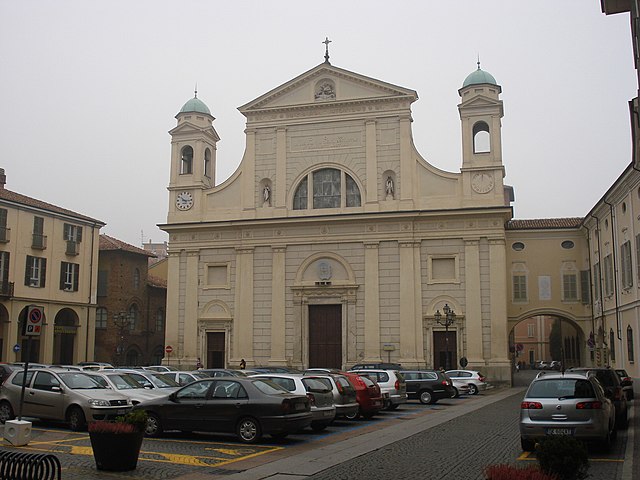Tortona
Comune in Piedmont, Italy From Wikipedia, the free encyclopedia
Comune in Piedmont, Italy From Wikipedia, the free encyclopedia
Tortona (Italian: [torˈtoːna]; Piedmontese: Torton-a [tʊrˈtʊŋa], locally [tʊrˈtɔŋa]; Latin: Dertona) is a comune of Piemonte, in the Province of Alessandria, Italy. Tortona is sited on the right bank of the Scrivia between the plain of Marengo and the foothills of the Ligurian Apennines. Its frazione of Vho is one of I Borghi più belli d'Italia ("The most beautiful villages of Italy").[3]
Tortona
| |
|---|---|
| Comune di Tortona | |
 | |
| Coordinates: 44°53′39″N 08°51′56″E | |
| Country | Italy |
| Region | Piedmont |
| Province | Alessandria (AL) |
| Frazioni | Torre Garofoli, Rivalta Scrivia, Vho, Mombisaggio, Castellar Ponzano, Bettole di Tortona, Torre Calderai |
| Government | |
| • Mayor | Federico Chiodi |
| Area | |
• Total | 99.66 km2 (38.48 sq mi) |
| Elevation | 122 m (400 ft) |
| Population (1 January 2021)[2] | |
• Total | 26,713 |
| • Density | 270/km2 (690/sq mi) |
| Demonym | Tortonesi |
| Time zone | UTC+1 (CET) |
| • Summer (DST) | UTC+2 (CEST) |
| Postal code | 15057 |
| Dialing code | 0131 |
| ISTAT code | 006174 |
| Patron saint | St. Marcian of Tortona |
| Saint day | 6 March |
| Website | Official website |


Known in ancient times as Dertona, the city was probably the oldest colony under Roman rule in the westernmost section of the Valley of the Po, on the road leading from Genua (Genoa) to Placentia (Piacenza). The city was founded c. 123–118 BC at the junction of the great roads; the Via Postumia and the Via Aemilia Scauri which merged to become the Via Julia Augusta. The site made Dertona an important military station under the Romans. Strabo speaks of it as one of the most considerable towns in this part of Italy, and from Pliny wrote that it was a Roman colony. Velleius mentions it among those founded under the Republic, it appears to have been recolonised under Augustus; some inscriptions therefore give it the title of Julia Dertona.[4] The assassin of Caesar, Brutus, encamped at Dertona on his march in pursuit of Mark Antony, after the Battle of Mutina,[5] and it was one of the places where a body of troops was usually stationed during the later ages of the empire.[6]
A bishopric was founded at Tortona early, but its first bishops are purely legendary, like Saint Marcianus of Tortona, called the first bishop of Piedmont and a disciple of Barnabas, the companion of Paul. Until the 9th century, the city was under the rule of its bishop; in 1090 it became a free commune with the name of Terdona. In 1133 the diocese was separated from the archbishopric of Milan to the new archdiocese of Genoa (CE "Lombardy").
In 1155 Frederick Barbarossa besieged, captured and leveled Tortona to the ground, leaving not one stone upon another.[7]
During the Middle Ages, Tortona was a faithful ally of the Guelphs and was destroyed several times, notably by Frederick Barbarossa.[8] From 1260 to 1347 the city was dominated by a series of different Italian noble families and adventurers. In 1347, Tortona was decisively incorporated into the territories of the Duchy of Milan, under which remained until 1735. One of the rulers in this period was Facino Cane, who in the unsettled affairs of Lombardy had assembled a string of lordships and great wealth which he bequeathed to his wife, Beatrice, and arranged with his friends that a marriage should be effected between her and Filippo Maria Visconti. According to Machiavelli[9] "By this union Filippo became powerful, and reacquired Milan and the whole of Lombardy. By way of being grateful for these numerous favors, as princes commonly are, he accused Beatrice of adultery and caused her to be put to death".[10] Then following the vicissitudes of the War of the Polish Succession, the city was occupied by the King of Sardinia, and "count of Tortona" was added to the titles of the House of Savoy.
Tortona is the capital of an area known as Colli Tortonesi, which stretches from the town to the border with Liguria. The area is known for the variety and of its products and for the intensive wine production, including Barbera, Dolcetto, Moscato and Timorasso, the autochthonous wine of the region which traces its origin back to the 14th century. Truffles are another important fruit of this land and the Colli Tortonesi is the only place in Piedmont to have three varieties of truffle: White truffle, Black Truffle and scorzone.
People born in Tortona, or with close links to the town, include:

Seamless Wikipedia browsing. On steroids.
Every time you click a link to Wikipedia, Wiktionary or Wikiquote in your browser's search results, it will show the modern Wikiwand interface.
Wikiwand extension is a five stars, simple, with minimum permission required to keep your browsing private, safe and transparent.